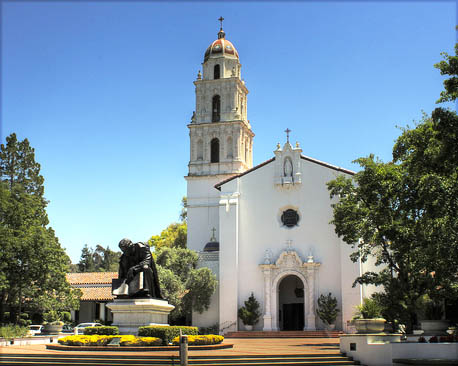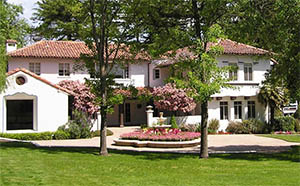CITY PROFILE: Moraga
Moraga is one of the three cities that form the affluent community known as "Lamorinda", which also includes the separate cities of Lafayette and Orinda. This area is bordered on the west and south by a high ridge separating it from Alameda County and on the east and north by the relatively flatter terrain of Walnut Creek, Pleasant Hill, and Martinez. Moraga is the home of St. Mary's College (right).
While the other Lamorinda towns stretch along Highway 24 which is the main route to Oakland/San Francisco, Moraga is more secluded to the south of the rest of Lamorinda. Northern Moraga is surrounded by Lafayette and Orinda neighborhoods, and southern Moraga is surrounded by high-hills and open space.
There are three typical ways to come and go from Moraga: Moraga Way through Orinda, Moraga Road through downtown Lafayette, and St Mary's Road (and other roads), through residential Lafayette to Olympic Blvd in Walnut Creek. A fourth option is to drive back-roads through Canyon and the Oakland Hills to Skyline or Hayward.
There is very little land in the city on which to build new homes, so generally, people who want modern amenities renovate homes which were built during the 1940's through early 1960's. More older homes, pre-1960s, are available in Lafayette and Orinda; most of Moraga was built during the 1960s and 1970s. A few large subdivisions such as prestigious Sanders Ranch and Moraga Country Club being built in the 1980s and 1990s, with some continuing construction.
Moraga benefits from a high proportion of open space, excellent schools, larger than average homes with generous lot sizes, homogeneous neighborhoods, and a strong sense of community. Moraga suffers from lack of direct access to highways and transportation, and has only modest retail and entertainment opportunities. Moraga is one of the most sought-after communities in the east bay area.
HISTORY:
Moraga is located on a 1835 Mexican Land Grant to the Moraga family who trace their lineage back to the Spanish conquistadors. The Moraga Adobe has been preserved, but is located in neighboring Orinda (photo right).
Joaquin Moraga sold three pieces of his rancho in the 1850s: lumber interests in Canyon to Lafayette’s founder, Elam Brown in 1853, six acres to John Courter in 1854, where a store and commercial interests were established, and forty acres in what is now Sanders Ranch to Isaac Gann in 1855. The rest of the ranch was lost to squatters and legal machinations in the Civil War era and through the 1880s. Moraga's first post office opened in 1886.
In 1912, most of the original rancho was purchased by the owner of the Moraga Land Company which planted many acres of pear and walnut trees, grazed cattle on the hillsides and had as many as 150 mostly Portuguese sharecroppers in the Moraga Valley. The Moraga Land Company also sold land to developers and subdivided land itself. In 1913, they established the Townsite of Moraga, near the intersection of Moraga Road and Moraga Way. They tried unsuccessfully to sell residential lots there.
In the first half of the 20th century the Sacramento Northern Railroad, and its predecessor ran through Moraga; much of the old right-of-way is now part of the Lafayette-Moraga Regional Trail.
In 1927, The Moraga Company gave 100 acres to Saint Mary's College (of Oakland) which also bought an additional 300 acres, and opened their campus in 1928.
In 1934 Donald Rheem, son of the President of Standard Oil, bought 20 acres of the one farm which had not been acquired by the Moraga Land Company. The site had been developed in 1916 as an orphanage; through renovation and expansion Rheem developed an impressive horse estate with a Spanish style mansion (photo left), stables, a golf course, and a race track. During World War II Rheem increased his fortune through government contracts, and post war the Rheem family made the ranch their residence.
In the late 1950s, Rheem built the Rheem Shopping Center and the Rheem Theatre near the intersection of Moraga Road and Rheem Blvd. He redirected mail for his industries to the area which resulted in the Post Office opening a Rheem branch. He also subdivided some of his land and built some homes. This area became known as Rheem by locals and as a postal address.
The Rheem home is preserved as the Hacienda, a city owned event facility, and his stables have been converted to a home on Devin Drive.
In 1935, most of the Moraga Land Company holdings were bought by Utah Construction and Mining Company, and they bought the remainder in 1947. Many subdivisions and homes were started, but they sold their interests to developer Russell Bruzzone in the early 1960s; he developed most of the property in the 1960s and 1970s. Campolindo High School was opened in 1962.
In 1974, Moraga was incorporated as a town which includes both the communities of Moraga and Rheem.
HOUSING:
The opening of the Caldecott Tunnel in 1937 and a postwar exodus from the urban areas fired tremendous growth in Contra Costa County the 1950's. Lafayette and Orinda became a geographical extension of the affluent Oakland/Berkeley Hills area. Moraga developed more slowly as a more affordable alternative to Orinda and Lafayette, but offering an upscale alternative to more modest developments in Walnut Creek, Pleasant Hill and Concord. In a way, Moraga preceded Danville in supplying upscale family neighborhoods at affordable prices. The map linked above shows the locations of the neighborhoods discussed in this section along with showing the decade of development.
While many longtime residents recognize traditional value distinctions among the neighborhoods, newcomers to Moraga see the community as rather homogeneous, and select homes more on the individual amenities than location. While programs and cultures vary among the three elementary schools, all schools are virtually identical in test scores and API ratings. But there are certainly value distinctions with some areas commanding high prices.
Sanders Ranch (photo right), a gated community substantially developed in the 1980s and 1990s, typically has the highest concentration of top-value sales. Moraga Country Club was established in the mid 1970's and most construction was completed by the mid 1980s. Due to smaller lot sizes and the high percentage of attached housing, sales prices in the Country Club tend to be lower. The Campolindo area, in the north off of Moraga Road area tends to be more affordable than equivalent areas to the south.
In the south of town, the homes off of Larch Avenue and Sanders Drive date back to the late 1950s to the mid 1960s with some infill projects of more recent construction. Values are typically higher further into the developments (up the hill), with larger view homes on prestigious streets such as Carr Drive. The neighborhoods off of Camino Pablo and Rimer Drive, south of Larch, are typically a bit newer with flatter terrain and on average larger homes. All of these neighborhoods continue to climb in value in relation to the rest of town as more homes are renovated, and the age distinction compared to Sanders Ranch becomes less critical as the latter ages.
Roughly in the middle of town are the Corliss area which was built from the early 1960s to the early 1970s, and Rheem Valley manor was built in the early 1970s with large lots. These trend to be well built homes which have commanded high prices and were among the highest values prior to the building of Sanders Ranch. Now with extensive renovations of these homes and the aging of Sanders Ranch homes the relative values are increasing here and in adjacent neighborhoods.
The Bluffs,off of Bollinger Canyon Road just south of St Mary's College, was mostly developed in the late 1960s through the early 1970s. The Campolindo and St Mary's Garden area were developed in the early 1970s. Other smaller neighborhoods such as Sonsara (left photo) and Laird Drive have been developed since 2000, with the latter still growing.
SCHOOLS:
Moraga schools are among the finest in the Bay Area and State. The Moraga Elementary District, which provides K- 8 education, achieved a 956 API rating for 2013. Kids attend one of three neighborhood elementary schools from K - 5. At 6th grade they progress to Joaquin Moraga Intermediate which serves the entire district.
2013 API scores vary slightly among the elementary schools, from 962 for Camino Pablo Elementary (south) to 961 for Donald L. Rheem Elementary (north) and 958 for Los Perales Elementary (central). Joaquin Moraga Intermediate achieved a 2013 API rating of 951.
Kids transfer to the Acalanes High School District for the ninth grade. This is a four school district, where Moraga students are assigned to one of two high schools: Campolindo High (photo right) or Miramonte High (very few), API ratings of 921 and 932 respectively. Most Moraga students attend Campolindo, but some neighborhoods, mostly on the Orinda border along Moraga Way and in the Country Club attend Miramonte. A school finder page by street is available at the district site.





